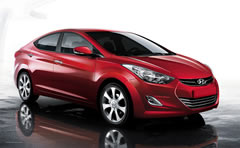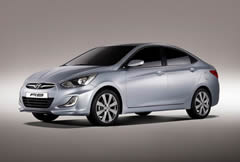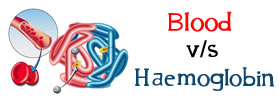Difference between Hyundai Elantra and Hyundai Verna
Key Difference: The Elantra and Verna are both sedan cars designed by Hyundai. However, the Hyundai Elantra is considered superior than the Verna as it has more power and features.
 The Hyundai Elantra is a car that was launched in 1990 and is still in production. It is in its fifth generation which was launched in 2010. The same car is marketed as Hyundai Avante in South Korea. The fifth generation Elantra follows the fluidic sculpture design of Hyundai. It is being produced and sold in most of the markets of the world; though the name may differ. It is available in two engine options i.e. petrol/gasoline and diesel; both with engine capacities of 1.8 and 1.6 litre. The features include music system, rear air conditioning vents, rear parking sensors with camera, Bluetooth, rear defogger and wiper, etc. In India, there are two engine options i.e. 1.8 litre petrol/gasoline and 1.6 litre diesel with manual and automatic transmissions.
The Hyundai Elantra is a car that was launched in 1990 and is still in production. It is in its fifth generation which was launched in 2010. The same car is marketed as Hyundai Avante in South Korea. The fifth generation Elantra follows the fluidic sculpture design of Hyundai. It is being produced and sold in most of the markets of the world; though the name may differ. It is available in two engine options i.e. petrol/gasoline and diesel; both with engine capacities of 1.8 and 1.6 litre. The features include music system, rear air conditioning vents, rear parking sensors with camera, Bluetooth, rear defogger and wiper, etc. In India, there are two engine options i.e. 1.8 litre petrol/gasoline and 1.6 litre diesel with manual and automatic transmissions.
 The Hyundai Verna is a sedan car that is also marketed as the Accent in many countries and markets. The production of the Hyundai Accent/Verna was started in 1995 and is in its fourth generation in the market. The fourth generation Verna/Accent was launched in November 2010. Many hatchback versions of the car are also available in different markets. The Hyundai Verna is available in the 1.4 litre and 1.6 litre petrol; as well as 1.4 litre and 1.6 litre diesel options in various markets. In India, all the four options are available for the customers. It has features like Brake Assistance, ABS, audio system with Bluetooth and USB playback, etc.
The Hyundai Verna is a sedan car that is also marketed as the Accent in many countries and markets. The production of the Hyundai Accent/Verna was started in 1995 and is in its fourth generation in the market. The fourth generation Verna/Accent was launched in November 2010. Many hatchback versions of the car are also available in different markets. The Hyundai Verna is available in the 1.4 litre and 1.6 litre petrol; as well as 1.4 litre and 1.6 litre diesel options in various markets. In India, all the four options are available for the customers. It has features like Brake Assistance, ABS, audio system with Bluetooth and USB playback, etc.
Comparison between Hyundai Elantra and Hyundai Verna:
|
|
Hyundai Elantra |
Hyundai Verna |
|
Engine Displacement (CC) |
Petrol: 1797 Diesel: 1582 |
Petrol: 1396 & 1591 Diesel: 1396 & 1582 |
|
No. Of Cylinders |
4 |
4 |
|
Max Power (PS) |
Petrol: 149.5 PS@6500rpm Diesel: 128PS@4000rpm |
Petrol 1.4: 107PS @6300rpm Petrol 1.6: 123PS @6300rpm Diesel 1.4: 88bhp@4000rpm Diesel 1.6: 128PS @4000rpm |
|
Max Torque (NM) |
Petrol: 104 Nm@4700rpm Diesel: 260 Nm @ 1900-2750rpm |
Petrol 1.4: 138Nm @5000rpm Petrol 1.6: 155Nm @4200rpm Diesel 1.4: 380Nm@1750-2750 Diesel 1.6: 265Nm @1900rpm |
|
Transmission |
Manual and Automatic |
Manual and Automatic |
|
No of gears (Gears) |
6 |
Manual: 5; and 6 in Diesel 1.6 Automatic: 4 |
|
Fuel Type |
Petrol and Diesel |
Petrol and Diesel |
|
Fuel Tank Capacity (litre) |
56 |
43 |
|
Turning Radius (metre) |
5.06 M |
5.2 M |
|
Ground Clearance |
185 mm |
170 mm |
|
Boot Space (litre) |
420 |
454 |
|
Length (mm) |
4,530 |
4,370 |
|
Width (mm) |
1,775 |
1,700 |
|
Height (mm) |
1,470 |
1,475 |
|
Wheelbase (mm) |
2,700 |
2,570 |
|
Front Suspension |
McPherson strut type with coil spring |
Petrol and Diesel 1.4: McPherson strut with stabilizer bar Petrol and Diesel 1.6: McPherson strut with coil spring |
|
Rear Suspension |
Coupled torsion beam axle |
Coupled torsion beam axle |
|
Front Brake Type |
Disc |
Disc |
|
Rear Brake Type |
Disc |
Disc; Drum in Petrol 1.4 |
|
Front Tyres |
Tubeless, 205 / 60 R16” |
Petrol and Diesel 1.4: Tubeless, 185 / 65 R15” Petrol and Diesel 1.6: Tubeless, 195 / 55 R16” |
|
Rear Tyres |
Tubeless, 205 / 60 R16” |
Petrol and Diesel 1.4: Tubeless, 185 / 65 R15” Petrol and Diesel 1.6: Tubeless, 195 / 55 R16” |
|
0-60 (seconds) |
N/A |
Petrol 1.4: N/A Petrol 1.6: 5.24 Diesel 1.4: N/A Diesel 1.6: N/A |
|
0-100 (seconds) |
N/A |
Petrol 1.4: N/A Petrol 1.6: 11.48 Diesel 1.4: N/A Diesel 1.6: N/A |
|
Top Speed (KPH) |
N/A |
Petrol 1.4: N/A Petrol 1.6: 190 Diesel 1.4: N/A Diesel 1.6: 190 |
|
Seating Capacity (Person) |
5 |
5 |
|
ABS(Anti-Lock Braking System) |
Yes |
Petrol 1.4: No Petrol 1.6: Yes Diesel 1.4: Yes Diesel 1.6: Yes |
|
EBD (Electronic Brake-force Distribution) |
Yes |
Petrol 1.4: No Petrol 1.6: Yes Diesel 1.4: Yes Diesel 1.6: Yes |
|
Electronic Stability Program |
Yes |
No |
|
Brake Assist |
No |
Only in Diesel 1.6 MT & AT and Petrol 1.6 AT |
|
Traction Control System |
No |
No |
|
Airbags |
4 (Driver, Co-Driver & Rear Passengers) and 6 Airbags in 1.8 SX MT model |
Petrol 1.4: No Petrol 1.6: 1 (Driver Only) Diesel 1.4: 6 Airbags Diesel 1.6: 6 Airbags |
|
Steering Type |
EPS (Electronic Power Steering) with Tilt and telescopic feature |
EPS (Electronic Power Steering) with Tilt feature |
|
Cruise Control |
Yes |
No |
Note: Comparison is made between the top models and may vary among different markets.
Image Courtesy: fiel-zao.blogspot.com, indiancarsbikes.in









Comments
both elantra diesel and verna diesel have the same engine.... is the power any different.
kiran
Wed, 04/16/2014 - 22:51
Elantra has comparatively more power.
Rishabh Goyal
Sat, 01/17/2015 - 21:47
Add new comment